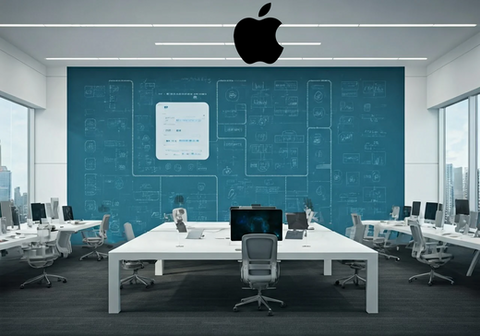What does the Apple org chart look like?
The Apple org chart typically shows a top-down hierarchy with the CEO, followed by senior executives leading various departments like design, marketing, operations, and finance. The chart emphasizes Tim Cook's approach with strong leadership at the helm and a focus on innovation and design excellence.

Key Highlights
- Apple's organizational structure is a functional matrix that is highly centralized, emphasizing areas of expertise over individual products.
- Tim Cook leads as CEO, supported by senior vice presidents responsible for functions like hardware engineering and machine learning.
- Collaboration and well-defined roles are central to Apple's success, facilitating rapid innovation and product development.
- Apple's culture is characterized by secrecy, excellence, and a strong emphasis on accountability.
- The company prioritizes a limited number of high-quality products, contributing to brand recognition and profitability.
- Apple's unique approach has positioned it as an industry leader, demonstrating the power of defying conventional wisdom.
Introduction
Apple Inc. stands out because of its special organizational structure, which, although common for small entrepreneurial firms, is tied to its corporate president and a strong organizational culture. It helps Apple make decisions together and stay committed to being the best in technology, including how it developed its first computers. By looking at how Apple is set up inside, we can learn a lot about its amazing success.
The Foundation of Apple's Organizational Structure

Apple's organizational structure is unique because it is centralized and hierarchical, a choice made by the late Steve Jobs, Steve Wozniak, and Ronald Wayne, former CEO. This is very different from the decentralized structures used by many other tech companies. It focuses on functional expertise rather than individual products.
This way of working makes communication smooth and decisions quick, which helps Apple innovate and launch products fast. It shows their dedication to being efficient and having a clear vision. This principle is a big part of their organization.
Hierarchical and Functional Organization Explained
Apple's organization is structured in a clear way. At the top is the CEO of Apple, Apple CEO Tim Cook, a former president of various tech initiatives. He is in charge of the company's overall direction, supported by the Apple board of directors. Below him is a group of senior vice presidents who are in charge of functions, leading important areas of the company.
Apple also divides its work into specialized departments. These include hardware engineering, software engineering, and marketing. This setup helps each department focus and develop their skills. This focus plays a big role in creating Apple's advanced and user-friendly products.
The Importance of Chain of Command in Decision-Making
Apple has a clear chain of command that helps in making decisions quickly. This structure makes sure that choices are made by the right people and shared well across the company.
This isn't a barrier to new ideas, though. It actually helps with communication and responsibility. By making the decision process smoother, Apple, akin to CNET's findings and similar to what the Washington Post has noted, can react fast to shifts in the market and stay ahead of its rivals.
Key Departments Driving Apple's Success
Apple is successful because its important departments work well together. Each department plays a key part in the company's plan. They come up with new technology, create stylish designs, and ensure great customer experiences. All these teams are essential to how Apple runs.
This teamwork means that every step of making a product, from the first idea to the final product, meets Apple's high standards for quality, design, and user experience.
Engineering: The Heart of Innovation
At the center of Apple's creativity in Cupertino is its engineering department. This team is full of experts working on the hardware and software that shape the Apple experience. It is led by a senior vice president and includes teams focused on:
- Hardware engineering: This team works on the physical parts of Apple products. They make sure the design and function work well together.
- Software engineering: This group creates and updates the operating systems and apps for Apple devices. They ensure everything is user-friendly and easy to use.
Apple's strong drive for new ideas helps it push the limits of technology. They regularly deliver products that are powerful and stylish.
Marketing and Design: Crafting the Apple Experience
Apple's marketing and design teams work closely together to create the famous "Apple Experience." They carefully design every part of the customer journey. This includes:
- Building a brand image that shows stylish design, the latest technology, and a desirable lifestyle.
- Creating engaging marketing campaigns that connect with the target audience, stirring excitement and interest in Apple products.
Under the watch of the chief operating officer, these teams are important for shaping how people see the brand. They help strengthen Apple's status as a top-quality brand.
Product Categories and Their Impact
Apple's product range is limited, but it greatly affects the tech industry and the company's revenue, especially in the year September and November, as reported by The New York Times. By concentrating on a few main product categories, Apple makes good profits and builds a strong brand image.
This focused strategy helps Apple improve its products in each category. It allows them to maintain high quality and keep customers happy.
The Role of iPhone and Mac in Apple's Portfolio
The iPhone, iPad, and Mac are key products for Apple. They help the company stay on top in the tech world. These devices, which can utilize various storage devices, are known for their stylish designs, easy use, and new technology. They also bring in a lot of money for Apple's profits.
The iPhone has changed how we communicate with our phones. It sets the standard for how smartphones look and work. The Mac is strong and easy to use, making it popular with creative workers and daily users.
How Services Contribute to Apple's Growth
Beyond hardware, Apple's services segment has become an increasingly important driver of the company's overall growth. This segment encompasses a range of digital offerings, including:
|
Service |
Description |
|
App Store |
A platform for downloading apps, games, and digital content, contributing significantly to Apple's revenue. |
|
Apple Music |
A music streaming service that rivals Spotify and offers a vast library of songs and curated playlists as of June. |
|
iCloud |
A cloud storage and syncing service that seamlessly integrates across Apple devices. |
These services not only enhance the user experience of Apple products but also create a sticky ecosystem, encouraging customer loyalty and generating recurring revenue streams.
Leadership and Control at Apple

Leadership at Apple has played a big role in the company's journey. From the early days with Steve Jobs to now with Tim Cook, leadership has left its mark, particularly in the realm of intellectual property, as noted by the Los Angeles Times. It is not just about having a plan for the future. It is also about creating a culture where innovation, teamwork, and responsibility thrive, especially since October 2014 in Italy.
A strong sense of control is a major part of how Apple is managed. This helps the company make quick decisions. It can adapt quickly to changes in the market. Some people think this kind of control can hold back creativity, but there is no doubt that it has brought great success. This has helped Apple become a powerful name in the world today.
Senior Executives' Role in Steering Product Development
Senior leaders at Apple Computer, including Alex Gorsky, are very important in guiding product development. They make sure every new product matches the company's goals and dedication to new ideas. Steve Jobs, famous for his sharp eye for detail and strong drive for perfection, helped Apple Computer become a leader in stylish design and easy-to-use technology, especially after the pivotal changes made in April during their key product launches, which were influenced by Ron Johnson's initiatives and Michael Spindler's operational strategy.
This idea is still important under Tim Cook. Now, he focuses more on how the company runs and manages its supply chain, a topic frequently covered in the Wall Street Journal. Senior leaders, along with their teams, work hard to ensure that each product meets Apple’s strict standards, from the first ideas all the way to final production, unlike companies such as Facebook that hoard data.
Collaboration and Innovation within Product Teams
Leadership at Apple sets the vision. However, it's the teamwork and creative energy in product teams that make Apple's products happen. These teams include skilled engineers, designers, and marketers who work well together. They use their different skills to develop the latest technology.
Apple encourages open talks and sharing ideas. Team members are urged to question assumptions and explore new possibilities. This way of working, combined with a strong drive for new ideas, shows how the company looks into new technologies like artificial intelligence (AI) and augmented reality.
Does the Databahn Research Team offer a more detailed and comprehensive deep dive Apple Company Profile and Org Chart Report?
Yes, the Databahn Research Team track and report on Apple Inc. with the most comprehensive and detailed deep dive report in the global marketplace. The Apple Company Profile and Org Chart Report is updated and refreshed on a quarterly basis and the Databahn research team also offer custom services to research your specific focus areas within the Apple organization. Go here to purchase and download the deep dive Apple Company Profile and Org Chart Report now.
Conclusion
In conclusion, Apple's way of organizing its business units and teams is very important for its success and new ideas. They have a layered setup that highlights the chain of command. Important departments, such as Engineering and Marketing, help a lot. Products like the iPhone, Mac, and Services are crucial for Apple's growth. Their leaders guide teamwork and creativity, which leads to great products. It’s helpful to know how Apple makes decisions to understand how they create their famous products and services. For a deeper view of Apple's organizational structure and key decision-makers, check out the detailed insights we have above.


